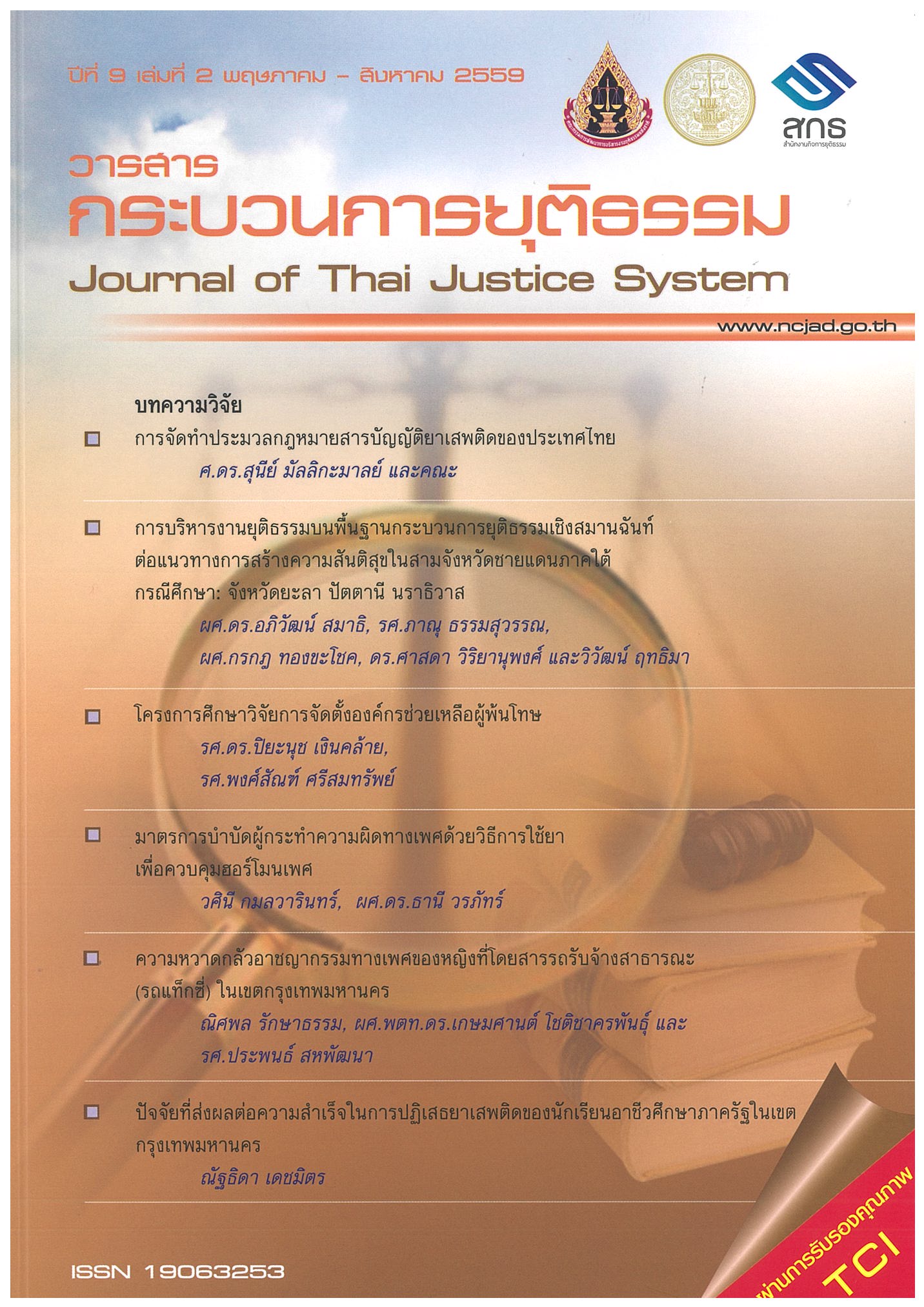ปัจจัยที่ส่งผลต่อความสำเร็จในการปฏิเสธยาเสพติดของนักเรียนอาชีวศึกษาภาครัฐในเขตกรุงเทพมหานคร
Main Article Content
บทคัดย่อ
การวิจัยครั้งนี้มีวัตถุประสงค์เพื่อศึกษาเปรียบเทียบระดับความรู้และทักษะการปฏิเสธยาเสพติดและศึกษาปัจจัยที่มีผลต่อความสำเร็จในการปฏิเสธยาเสพติดของนักเรียนอาชีวศึกษาภาครัฐในเขตกรุงเทพมหานคร ซึ่งเป็นการวิจัยเชิงปริมาณโดยใช้แบบสอบถามกับนักเรียนนักศึกษาอาชีวศึกษาที่ศึกษาอยู่ในรดับชั้นประกาศนียบัตรวิชาชีพ (ปวช.) ของสถานศึกษาที่เข้าร่วมโครงการสถานศึกษาสีขาวหรือโครงการ To be Number One จำนวน 400 คนวิเคราะห์ข้อมูลโดยใช้สถิติการแจงค่าความถี่ ค่าอัตราส่วนร้อยละ ค่าเฉลี่ยเลขคณิต ค่าส่วนเบี่ยงเบนมาตรฐาน การวิเคราะห์เปรียบเทียบ (Independent t-test และ One way ANOVA)และ การวิเคราะห์ถดถอยพหุแบบเชิงชั้น (Multiple regression analysis)
ผลการวิจัยพบว่า นักเรียนอาชีวศึกษาที่ระดับชั้นแตกต่างกันจะมีระดับความรู้และทักษะในการปฏิเสธยาเสพติดแตกต่างกัน และจากการศึกษาปัจจัยที่มีความสัมพันธ์กับการปฏิเสธยาเสพติดของนักเรียนอาชีวศึกษาภาครัฐในเขตกรุงเทพมหานครพบว่า ปัจจัย ด้านการควบคุมจนเองมีความาสัมพันธ์กับการปฏิเสธยาเสพติดของนักเรียนอาชีวศึกษาภาครัฐในเขตกรุงเทพมหานคร อย่างมีนัยสำคัญทางสถิติที่ระดับ 0.05 และปัจจัยด้านการควบคุมตนเองสามารถทำนายความสำเร็จในการปฏิเสธยาเสพติดของนักเรียนอาชีวศึกษาภาครัฐในเขตกรุงเทพมหานครได้ร้อยละ 11.6
ดังนั้น ควรส่งเสริมให้สถานศึกษาเข้าร่วมโครงการสถานศึกษาสีขาวและโครงการ To be Number One เนื่องจากผลการศึกษาพบว่าโรงเรียนอาชีวศึกษาภาครัฐที่เข้าร่วมโครงการดังกล่าวมีส่วนช่วยให้นักเรียนอาชีวศึกษามีความรู้และมีทักษะในการปฏิเสธยาเสพติดในระดับมาก อีกทั้งควรส่งเสริมการ ควบคุมตนเองของนักเรียนอาชีวศึกษาให้มีความเข้าแข็ง เพื่อให้นักเรียนอาชีวศึกษาให้มีทักษะในการปฏิเสธยาเสพติด สามารถที่จะคิดไตร่ตรอง ถึงผลดีผลเสียของยาเสพติด และ อดทน อดกลั้นต่อคำชักชวนให้ทดลองยาเสพติดซึ่งจะทำให้นักเรียนมีภูมิคุ้มกันที่ดีในเรื่องยาเสพติด และควรสนับสนุนให้นักเรียนอาชีวศึกษาต่างระดับชั้นได้แลกเปลี่ยนความรู้ในเรื่องยาเสพติดและทักษะในการปฏิเสธยาเสพติดในรูปแบบพี่สอนน้อง เนื่องจากทักษาะในการปฏิเสธยาเสพติดของนักเรียนส่วนหนึ่งเกิดจจากประสบการณ์ การเรียนรู้ และเพิ่มขึ้นตามระดับการศึกษา
Article Details
ต้นฉบับที่ได้รับการตีพิมพ์ในวารสาร เป็นลิขสิทธิ์ของวารสารกระบวนการยุติธรรม แต่ความคิดเห็นที่ปรากฏในเนื้อหาของบทความในวารสารกระบวนการยุติธรรม ถือเป็นความรับผิดชอบของผู้เขียนแต่เพียงผู้เดียว
เอกสารอ้างอิง
กระทรวงศึกษาธิการ. (2556). คู่มือแนวทางการดำเนินงานโครงการสถานศึกษาสีขาวปลอดยาเสพติดและอบามุข. กรุงเทพฯ:ผู้แต่ง.
กิตติ ปรมัตถผล และโสภณ เสือพันธ์. (2556). การป้องกันตนเองจากภัยสังคม. กรุงเทพฯ: สำนักพิมพ์เอมพันธ์จำกัด.
จิรวรรณ สารสิทธิ์. (2550). การพัฒนาทักษะชีวิตเพื่อป้องกันการติดยาเสพติดของนักเรียนชั้นมัธยมศึกษาตอนต้นในเขตเทศบาลตำบล ท่าฉาง อำเภอท่าฉาว จังหวัดสุราษฎร์ธานี. รายงานการศึกษาอิสระรัฐประศาสนศาสตรมหาบัณฑิต สาขาการปกครองท้องถิ่น,วิยาลัยการปกครองท้องถิ่น มหาวิทยาลัยขอนแก่น.
ชาญคณิต กฤตยา สุริยะมณี. (2554). ทฤษฎีอาชญาวิทยาร่วมสมัยกับการวิจัยทางด้านอาชญาวิทยาในปัจจุบัน. นนทบุรี:หยินหยางการพิมพ์.
ปิยาพัทธ์ อารีญาติ. (2549). พฤติกรรมการป้องกันตนเองจากการเสพยาบ้าของนักเรียนช่วงชั้นที่ 3 ในอำเภอแม่สาย จังหวัดเชียงราย. วิทยานิพนธ์ศิลปศาสตรมหาบัณฑิต สาขาจิตวิทยาชุมชน. มหาวิทยาลัยศิลปากร.
พรชัย ขันตี และคณะ. (2543). ทฤษฎีและงานวิจัยทางอาชญาวิทยา. กรุงเทพมหานคร: สำนักพิมพ์ บริษัท บุ๊คเน็ต จำกัด.
ศุภร ชินะเกตุ. (2553). ปัจจัยที่ส่งผลต่อพฤติกรรมป้องกันยาเสพติดของนักเรียนระดับประกาศนียบัตรวิชาชีพ สังกัดอาชีวศึกษาจังหวัดราชบุรี. วิทยานิพนธ์ศึกษาศาสตรมหาบัณฑิต, มหาวิทยาลัยศิลปากร.
ศูนย์ป้องกันและปราบปรามยาเสพติด. (2551). หนังสือศูนย์ป้องกันและปราบปรามยาเสพติดด่วนที่สุด ที่ ยธ 0759/712 เรื่องการตรวจหาสารเสพติดในปัสสาวะของเจ้าหน้าที่และผู้ต้องขัง, 1 เมษายน 2551.
ศูนย์อำนวยการต่อสู้เพื่อเอาชนะยาเสพติดแห่งชาติ. (2547). รายงานผลการสำรวจประเมินสถานาการณ์ยาเสพติด ครั้งที่ 4. กรุงเทพมหานคร: โรงพิมพ์คุารุสภาลาดพร้าว.
ศูนย์อำนวยการพลังแผ่นดินเอาชนะยาเสพติดแห่งชาติ. (2554). ปฏิบัติการวาระแห่งชาติ"พลังแห่งแผ่นดกินเอาชนะยาเสพติด"สาระสำคัญสถานการณ์ยาเสพติดและความหนาแน่นของปัญหายาเสพติดระดับอำเภอ. เอกสารอัดสำเนา.
สำนักงานคณะกรรมการป้องกันและปราบปรามยาเสพติด. (2552). ความรู้และแนวทางการป้องกันและแก้ไขปัญหายาเสพติด. พิมพ์ครั้ง 2. กรุงเทพฯ:สำนักงานคณะกรรมการป้องกันแบะปราบปรามยาเสพติด.
สุณีย์ กัลยะจิตร. (2557). ปัญหาการกระทำผิดของเด็กและเยาวชนแนวทางการป้องกันและแก้ไข. นครปฐม:สินทวี พริ้นติ้ง.
อริสรา สมิทธ์ปรีชา. (2550). ปัจจัยที่ส่งผลต่อการป้องกันยาเสพติดของยนักเรียนชั้นมัธยมศึกษาปีที่ 2 อำเภอพนมสารคาม จังหวัดฉะเชิงเทรา. วิทยานิพนธ์การศึกษามหาบัณฑิต,มหาวิทยาลัยบูรพา.
ภาษาอังกฤษ
Gottfredson, Michael and Travis Hirschi. (1990). A General Theory of Crime. Beverly Hills, CA: Sage.
WHO. (1994). Life Skill Education for Children and Adolescents in School. London:Department of Health.
เว็บไซต์
พินิตกาญ ตุลาชม. (2556). UN ทุ่มงบ 1.4 พันล้านเหรียญฯ ให้พม่าปราบยาเสพติดและอาชญากรรมข้ามชาติ. สืบค้นเมื่อ 20 มกราคม 2558, จาก http://www.voathai.con/content/burma-un-pt/2428096.html
ศูนย์เทคโนโลยีสารสนเทศและกำลังคนอาชีวศึกษา. (2557). สถิติข้อมูลนักเรียนนักศึกษาปีการศึกษา 2557. สืบค้นเมื่อ 25 กรกฎาคม 2558, จาก http://techno.vec.go.thtabid/766/ArticleID/3401/-2557.aspx
สำนักพัฒนาการป้องกันและแก้ไขปัญหายาเสพติด สำนักงานป้องกันและปราบปรามยาเสพติด. (2554). ความหมายของยาเสพติดและสารเสพติด. สืบค้นเมื่อ 20 มกราคม 255, จาก http://nctc.oncb.go.th/new/images/stories/atticle/year54difinitionofDrug.pdf
สำนักงานคณะกรรมการกฤษฎีกา. (2522). พระราชบัญญัติยาเสพติดให้โทษ พ.ศ. 2522. สืบค้นเมื่อ 20 มกราคม 2558, จาก http://www.cupsrisomdej.net/law/prbyasepitd.pdf
สำนักงานคณะกรรมการป้องกันและปราบปรามยาเสพติด. (2551). กรอบยุทธศาสตร์การแก้ไข ปัญหายาเสพติด ปี 2551. สืบค้นเมื่อ 20 มกราคม 2558, จาก www.nccd.go.th/upload/content/5strategy51.doc
สำนักงานคณะกรรมการป้องกันและปราบปรามยาเสพติด. (2553). สถานการณืยาเสพติดภายใต้ยุทธศาสตร์ 5 รั้วป้องกันระยะที่ 2 (ช่วง ตุลาคม 2552 - กันยายน 2553). สืบค้น เมื่อ 28 กรกฎาคม 2559, จาก http://www.nccd.go.th/upload/content/suj.pdf(7).pdf


